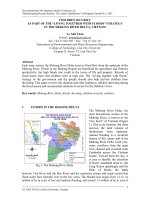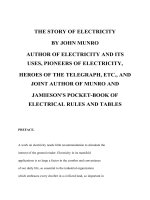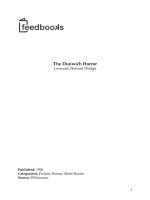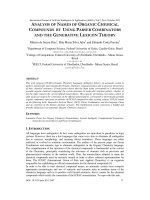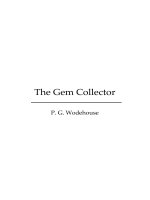The Story of the Living Machine, by H. W. Conn pptx
Bạn đang xem bản rút gọn của tài liệu. Xem và tải ngay bản đầy đủ của tài liệu tại đây (1.78 MB, 525 trang )
The Project Gutenberg EBook of The Story
of the Living Machine, by H. W. Conn
This eBook is for the use of anyone
anywhere at no cost and with
almost no restrictions whatsoever. You may
copy it, give it away or
re-use it under the terms of the Project
Gutenberg License included
with this eBook or online at
www.gutenberg.net
Title: The Story of the Living Machine
A Review of the Conclusions of Modern
Biology in Regard
to the Mechanism Which Controls the
Phenomena of Living
Activity
Author: H. W. Conn
Release Date: August 8, 2005 [EBook
#16487]
Language: English
*** START OF THIS PROJECT GUTENBERG EBOOK
THE STORY OF THE LIVING MACHINE ***
Produced by Juliet Sutherland, Janet
Blenkinship and the
Online Distributed Proofreading Team at
THE STORY OF
THE LIVING
MACHINE
A REVIEW OF THE
CONCLUSIONS OF
MODERN BIOLOGY IN
REGARD TO THE
MECHANISM WHICH
CONTROLS THE
PHENOMENA OF LIVING
ACTIVITY
BY
H.W. CONN
PROFESSOR OF BIOLOGY IN
WESLEYAN UNIVERSITY
AUTHOR OF THE STORY OF GERM
LIFE, EVOLUTION OF TO-DAY,
THE LIVING WORLD, ETC.
WITH FIFTY ILLUSTRATIONS
NEW YORK D. APPLETON AND
COMPANY 1903
Copyright, 1899,
By D. APPLETON AND COMPANY.
That the living body is a machine is a
statement that is frequently made without
any very accurate idea as to what it
means. On the one hand it is made with a
belief that a strict comparison can be
made between the body and an ordinary,
artificial machine, and that living beings
are thus reduced to simple mechanisms; on
the other hand it is made loosely, without
any special thought as to its significance,
and certainly with no conception that it
reduces life to a mechanism. The
conclusion that the living body is a
machine, involving as it does a
mechanical conception of life, is one of
most extreme philosophical importance,
and no one interested in the philosophical
conception of nature can fail to have an
interest in this problem of the strict
accuracy of the statement that the body is a
machine. Doubtless the complete story of
the living machine can not yet be told; but
the studies of the last fifty years have
brought us so far along the road toward its
completion that a review of the progress
made and a glance at the yet unexplored
realms and unanswered questions will be
profitable. For this purpose this work is
designed, with the hope that it may give a
clear idea of the trend of recent biological
science and of the advances made toward
the solution of the problem of life.
Middletown, Conn., U.S.A.
October 1, 1898.
CONTENTS.
PREFACE.
LIST OF ILLUSTRATIONS.
THE STORY OF THE LIVING
MACHINE.
PART I.
CHAPTER I.
CHAPTER II.
PART II.
CHAPTER III.
THE LIBRARY OF USEFUL
STORIES.
NEW EDITION OF HUXLEY'S
ESSAYS.
BOOKS FOR NATURE LOVERS.
introduction—Biology a new science—
Historical
biology—Conservation of energy—
Evolution—Cytology—New
aspects of biology—The mechanical
nature of living organisms—Significance
of the new
biological problems—Outline of the
subject 1
PART I.
THE RUNNING OF THE LIVING
MACHINE.
CHAPTER I.
IS THE BODY A MACHINE?
What is a machine?—A general
comparison of a body and
a machine—Details of the action of the
machine—Physical
explanation of the chief vital functions—
The
living body is a machine—The living
machine
constructive as well as destructive—The
vital factor 19
CHAPTER II.
THE CELL AND PROTOPLASM.
Vital properties—The discovery of cells
—The cell doctrine—The
cell—The cellular structure of organisms
—The
cell wall—Protoplasm—The reign of
protoplasm—The
decline of the reign of protoplasm—The
structure of protoplasm—The nucleus—
Centrosome—Function
of the nucleus—Cell division or
karyokinesis—Fertilization
of the egg—The significance of
fertilization—What is protoplasm?—
Reaction against
the cell doctrine—Fundamental vital
activities as
located in cells—Summary 54
PART II.
THE BUILDING OF THE LIVING
MACHINE.
CHAPTER III.
THE FACTORS CONCERNED IN THE
BUILDING OF THE LIVING
MACHINE.
History of the living machine—Evidence
for this
history—Historical—Embryological—
Anatomical—Significance
of these sources of history—Forces at
work in
the building of the living machine—
Reproduction—Heredity—Variation—
Inheritance of variations—Method of
machine building—Migration and
isolation—Direct influence of
environment—Consciousness—Summary
of Nature's power of building machines—
The origin of the cell
machine—General summary 131
LIST OF
ILLUSTRATIONS.
Figure_illustrating_osmosis
Figure_illustrating_osmosis
Diagram_of_the_intestinal_walls
Diagram_of_a_single_villus
Enlarged_figure_of_four_cells_in_the_villus_membrane
A_bit_of_muscle_showing blood-vessels
A_bit_of_bark_showing_cellular_structure
Successive_stages_in_the_division_of_the_developing_egg
A_typical_cell
Cells_at_a_root_tip
Section_of_a_leaf_showing_cells_of_different_shapes
Plant_cells_with_thick_walls_from_a_fern
Section_of_potato
Various_shaped_wood_cells_from_plant_tissue
A_bit_of_cartilage
Frogs_blood
A_bit_of_bone
Connective_tissue
A_piece_of_nerve_fibre
A_muscle_fibre
A_complex_cell_vorticella
An_amœba
A_cell_as_it_appears_to_the_modern_microscope
A_cell_cut_into_pieces_each_containing_a_bit_of_nucleus
A_cell_cut_in_pieces_only_one_of_which_contains_any_nucleus
Different_forms_of_nucleii
Two_stages_in_cell_division
Stages_in_cell_division
Latest_stages_in_cell_division
An_egg
Stages_in_the_process_of_fertilization_of_the_egg_1
Stages_in_the_process_of_fertilization_of_the_egg_2
Stages_in_fertilization_of_the_egg
Latest_stages_in_the_fertilization_of_the_egg
Two_stages_in_the_division_of_the_egg
A_group_of_cells_resulting_from_division_the_first_step_in_machine_building
A_later_step_in_machine_building_the_gastrula
The_arm_of_a_monkey
The_arm_of_a_bird
The_arm_of_an_ancient_half-bird_half-reptile_animal
Diagram_to_illustrate_the_principle_of_heredity
THE STORY OF THE
LIVING MACHINE.
INTRODUCTION.
Biology a New Science.—In recent years
biology has been spoken of as a new
science. Thirty years ago departments of
biology were practically unknown in
educational institutions. To-day none of
our higher institutions of learning
considers itself equipped without such a
department. This seems to be somewhat
strange. Biology is simply the study of
living things; and living nature has been
studied as long as mankind has studied
anything. Even Aristotle, four hundred
years before Christ, classified living
things. From this foundation down through
the centuries living phenomena have
received constant attention. Recent
centuries have paid more attention to
living things than to any other objects in
nature. Linnæus erected his systems of
classification before modern chemistry
came into existence; the systematic study
of zoology antedated that of physics; and
long before geology had been conceived
in its modern form, the animal and
vegetable kingdoms had been
comprehended in a scientific system.
How, then, can biology be called a new
science When it is older than all the
others?
There must be some reason why this, the
oldest of all, has been recently called a
new science, and some explanation of the
fact that it has only recently advanced to
form a distinct department in our
educational system. The reason is not
difficult to find. Biology is a new science,
not because the objects it studies are new,
but because it has adopted a new relation
to those objects and is studying them from
a new standpoint. Animals and plants have
been studied long enough, but not as we
now study them. Perhaps the new attitude
adopted toward living nature may be
tersely expressed by saying that in the past
it has been studied as at rest, while to-day
it is studied as in motion. The older
zoologists and botanists confined
themselves largely to the study of animals
and plants simply as so many museum
specimens to be arranged on shelves with
appropriate names. The modern biologist
is studying these same objects as intensely
active beings and as parts of an ever-
changing history. To the student of natural
history fifty years ago, animals and plants
were objects to be classified; to the
biologist of to-day, they are objects to be
explained.
To understand this new attitude, a brief
review of the history of the fundamental
features of philosophical thought will be
necessary. When, long ago, man began to
think upon the phenomena of nature, he
was able to understand almost nothing. In
his inability to comprehend the activities
going on around him he came to regard the
forces of nature as manifestations of some
supernatural beings. This was eminently
natural. He had a direct consciousness of
his own power to act, and it was natural
for him to assume that the activities going
on around him were caused by similar
powers on the part of some being like
himself, only superior to him. Thus he
came to fill the unseen universe with gods
controlling the forces of nature. The wind
was the breath of one god, and the
lightning a bolt thrown from the hands of
another.
With advancing thought the ideas of
polytheism later gave place to the nobler
conception of monotheism. But for a long
time yet the same ideas of the
supernatural, as related to the natural,
retained their place in man's philosophy.
Those phenomena which he thought he
could understand were looked upon as
natural, while those which he could not
understand were looked upon as
supernatural, and as produced by the
direct personal activity of some divine
agency. As the centuries passed, and man's
power of observation became keener and
his thinking more logical, many of the
hitherto mysterious phenomena became
intelligible and subject to simple
explanations. As fast as this occurred
these phenomena were unconsciously
taken from the realm of the supernatural
and placed among natural phenomena
which could be explained by natural laws.
Among the first mysteries to be thus
comprehended by natural law were those
of astronomy. The complicated and yet
harmonious motions of the heavenly
bodies had hitherto been inexplicable. To
explain them many a sublime conception
of almighty power had arisen, and the
study of the heavenly bodies ever gave
rise to the highest thoughts of Deity. But
Newton's law of gravitation reduced the
whole to the greatest simplicity. Through
the law and force of gravitation these
mysteries were brought within the grasp of
human understanding. They ceased to be
looked upon as supernatural, and became
natural phenomena as soon as the force of
gravitation was accepted as a part of
nature.
In other branches of natural phenomena the
same history followed. The forces and

